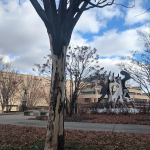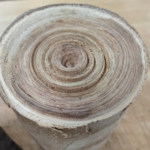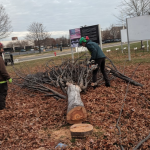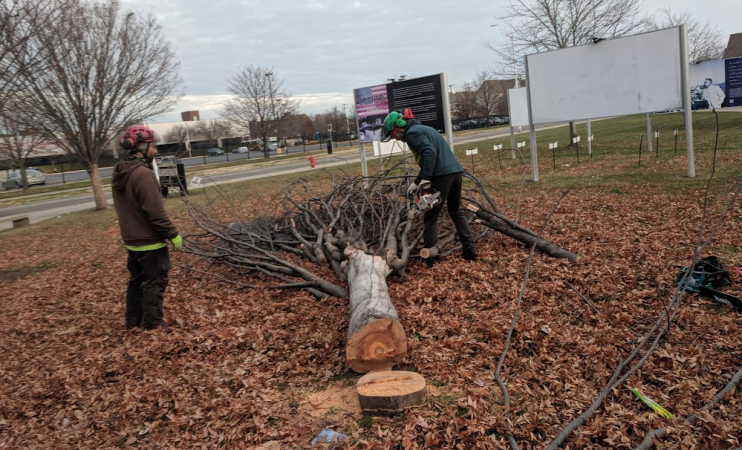On the surface, this is a story of the repurposing of a few fallen trees, but it goes unexpectedly deeper.
In 2018, the Charles H. Wright Museum of African American History (The Wright Museum) discovered three Zelkova trees on their grounds that were dying. These trees were marked for removal and destined to be mulched for compost.
The City of Detroit removes some 10,000 to 20,000 trees each year for various and necessary reasons. The timber is typically mulched. In line with its mission to be a zero-waste institution, those at The Wright began thinking that wood from these trees could be utilized for creative and practical endeavors, versus mulch. They also began to consider the deep roots the trees had in Detroit, growing in soil that contains memories of the land and African American history.

ZELKOVA TREE ON THE WRIGHT PROPERTY
From this line of thinking, a project emerged as a pilot for more ambitious levels of community and artistic engagement. In 2019, the Wright Museum and the College for Creative Studies (CCS) combined their respective institutional expertise to intentionally design a 15-week course on urban lumber, object making and story-making that framed an understanding of African material culture in the context of sustainability and tree experiences in Detroit.
The two institutions formed the d.Tree Studio, a course comprised of twelve makers. Five were students at the college, and seven – community members – were new and emerging artists with strong links to the city. All were enrolled in a class at the graduate level, where the seven community members were provided with a full scholarship.

ZELKOVA TREE LUMBER
The d.Tree Studio is co-led and driven by Leslie Tom, Chief Sustainability Officer at the Wright, and Ian Lambert, Dean of Graduate Studies at CCS. The course was taught by Ian Lambert with input and support from Leslie Tom, John Rizzo of CCS, and guest speakers. Participants learned about socio-cultural research methods (storytelling, listening, and inquiry) and practical woodworking techniques in the pursuit of artistic practice while exploring cultural place-making and narrative development methods.
Thus begins a tale that – amidst flooding, severe weather, and a pandemic that halted progress more than once – includes deep collaboration, remarkable creativity, unique learning experiences, community connection, African American history, sustainability, and growth. These trees and the way they were handled have changed the path of lives and continue to do so today.
Out of the three fallen trees came the powerful partnership between two institutions, the d.tree Studio itself, Design Core’s Treeposium, an impactful Listening Session that resulted in communities planting more trees with the help of CCS, an exhibit at CCS, and now an exhibit at The Wright, and within and around all of these happenings so many connections and collaborations have been made and continue to be made. It’s just remarkable, said Tom.

ZELKOVA TREE AT THE WRIGHT
She points to a student who knew little about woodworking upon taking the class who then became a woodshop monitor and is now a summer intern at The Wright. “This would never have happened if it weren’t for the three fallen trees.”
Of the impact the trees have created, Lambert says, “Between the carbon and sustainability aspect, and the African American history aspect this experience encapsulates both environmental and social justice. The dying trees gave us the opportunity to take this lumber and use it to mediate these concerns through creative artifacts, and that has become a very powerful narrative.”
According to Lambert, students looked at land injustice, land inequity, social justice, ancestral culture, and more and developed pieces that were beyond what he could have imagined.
He says, “One student created a large hair pick recognizing the intimacy between African American mothers and daughters when braiding each other’s hair. She became pregnant during the class, and when she presented her project, she unknowingly sat cradling the pick almost as if she was holding a child. It felt tender and serendipitous.”
He goes on to say, Another student who grew up in a rural town in Michigan and was a high school chess champion created a decolonized chess set that is round and rejects the idea of two opposing sides. The diversity of outcomes that the students produced was amazing.

CHESS BOARD
In the words of Jasmine Brown, a CCS student: “It’d be different if this was a studio class and we were just handed slabs of lumber to design something. But I feel like since the material, the Zelkova tree was bestowed to us and the way the class was handled was so appropriate and having to have all these experiences and meeting other local artists is what really made the program so enriched.”
Reuben Telushkin, a community scholarship student says, “If I didn’t have the d.Tree Studio project, I would still be going to big box stores and buying… wasteful plywood at a high premium… huge boxes of nails to screw it all together and just participating in this linear, wasteful economy that alienates me from what’s coming out of the ground on the land that I’m existing on.”
Yet Faith Serio, CCS Student, turned wood shop monitor, currently, the Wright Museum summer exhibitions intern, says, “The d.Tree Studio has also affected my creative process in a really positive way. Instead of just thinking about how I can complete things, I’m looking at problems in a more creative and more collaborative way and what can we do to work together to solve these problems.”
Says Tom, “One of the students who has graduated now collects wood scraps in neighborhoods and has become a maker.”
In September of 2021 as part of Design Core’s Month of Design, The Wright hosted Treeposium, a tree symposium that involved Detroit’s artists, educators, students, elders, and architects, and asked the question, “What have Detroit’s trees seen?’ Answers related to the African American experience in Detroit, the science of trees, and how they’re all connected.
In April, the project received a 2023 Excellence in Service Innovation Award from the International Society of Service Innovation Professionals.
As for the future, the neighboring institutions are excited to start to design d.Tree 2.0. Lambert says, “We have many concepts we are vetting now. We are seeking funding and sponsorships so that we can do a larger scale project.”
This exhibit used less than 2 Tons of Carbon to create this hyper-local project as we collected the materials from The Wright Museum and did not need to fly people or artifacts around the world. This low-carbon exhibition simply moved makers and artifacts across the street from CCS to The Wright for a new Exhibition – d.Tree Exhibition: Past, Present, Future of Detroit Trees – which runs July 20, 2023, through December 10, 2023.
As always, be sure to subscribe to our newsletter for regular updates on all things Detroit.























